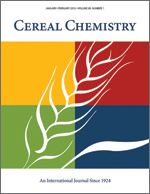
Cereal Chem 59:46 - 49. | VIEW
ARTICLE
Grinding Methods: Their Impact on Rice Flour Properties.
K. D. Nishita and M. M. Bean. Copyright 1982 by the American Association of Cereal Chemists, Inc.
California medium grain broken white rice was reduced to flour by grinding on seven different mills. The resulting flour particle size and functional properties were affected by the type of grinder used. Burr and blade mills gave coarse flours; the roller mill, an intermediate flour; and pin, hammer, and turbo mills, fine flours. The latter two mills also heated the flour more than the others. Coarser flours had less damaged starch and functioned better in 100% rice flour breads, whereas finer flours with more damaged starch were preferred for composite flour breads containing 30% rice. Water absorption capacity was greater for fine flours. The initial increase in amylograph viscosity started at a lower temperature for fine flours than for coarser ones. Differential scanning calorimetry of six rice flours of differing particle sizes gave different endotherms (Tmax) that paralleled microscopic gelatinization temperatures. Enthalpies determined by differential scanning calorimetry were lower for flours with a higher degree of damaged starch. Mill selection and processing procedures are therefore important considerations in the production of rice flours for different end-product uses.